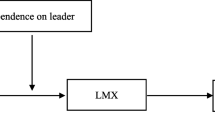Abstract
This study looks at the social exchange process between leaders and subordinates to examine a partnership-oriented relationship between leaders and members. We examine the relationship between high quality of leader-member exchange (LMX) and subordinates’ turnover intention (TI) in a Chinese context. We extend current research by empirically testing that subordinates’ satisfaction on career advancement opportunities moderates a U-Shaped relationship between LMX and TI. Hierarchical regression results supported our hypotheses and thus implied a dark side of partnership especially within high-performance work system where partnership is assumed to be highly efficient. Directions for future research are discussed.
This work is supported by Anhui Province Education Bureau’s Social Science Research Grant #2010sk180 to L. Huang.
Access this chapter
Tax calculation will be finalised at checkout
Purchases are for personal use only
Preview
Unable to display preview. Download preview PDF.
Similar content being viewed by others
References
Dienesch, R.M., Liden, R.C.: Leader-member exchange model of leadership: A critique and further development. Academy of Management Review 11, 618–634 (1986)
Gerstner, C.R., Day, D.V.: Meta-analytic review of leader-member exchange theory: Correlates and construct issues. Journal of Applied Psychology 82(4), 827–844 (1997)
Graen, G.R., Scandura, T.A.: Toward a psychology of dyadic organizing. In: Cummings, L.L., Staw, B.M. (eds.) Research in Organizational Behavior, vol. 9, pp. 175–208. JAI Press, Greenwich (1987)
Graen, G.B., Uhl-Bien, M.: Development of leader-member exchange (LMX) theory of leadership over 25 years: Applying a multi-level multi-domain perspective. Leadership Quarterly 6, 219–247 (1995)
Liden, R.C., Sparrowe, R.T., Wayne, S.J.: Leader-member exchange theory: The past and potential for the future. In: Ferris, G.R. (ed.) Research in Personnel and Human Resource Management, vol. 15, pp. 47–120. JAI Press, Greenwich, CT (1997)
Wayne, S.J., Shore, L.M., Liden, R.C.: Perceived organizational support and leader-member exchange: A social exchange perspective. Academy of Management Journal 40, 82–111 (1997)
Harris, K.J., Kacmar, K.M., Witt, L.A.: An examination of the curvilinear relationship between leader-member exchange and intent to turnover. Journal of Organizational Behavior 26, 363–378 (2005)
Maertz, C.P., Griffeth, R.W.: Eight motivational forces and voluntary turnover: A theoretical synthesis with implications for research. Journal of Management 30, 667–683 (2004)
Wilhelm, C.C., Herd, A.M., Steiner, D.D.: Attributional conflict between managers and subordinates: An investigation of leader-member exchange effects. Journal of Organizational Behavior 14, 531–544 (1993)
Harris, K.J., Kacmar, K.M.: Too much of a good thing: The curvilinear effect of leader-member exchange on stress. Journal of Social Psychology 146, 65–84 (2006)
Tett, R.P., Meyer, J.P.: Job satisfaction, organizational commitment, turnover intention, and turnover: Path analyses based on meta-analytic findings. Personnel Psychology 46, 259–293 (1993)
Hom, P.W., Griffeth, R.W.: Employee Turnover, 1st edn., pp. 29–36. South/Western Press, Cincinnati (1995)
Cohen, A.: Organizational commitment and turnover: A meta-analysis. Academy of Management Journal 36, 1140–1157 (1993)
George, J.M., Jones, G.R.: The experience of work and turnover intentions: Interactive effects of value attainment, job satisfaction, and positive mood. Journal of Applied Psychology 81, 318–325 (1996)
Liden, R.C., Maslyn, J.M.: Multidimensionality of leader-member exchange: An empirical assessment through scale development. Journal of Management 24, 43–72 (1998)
Author information
Authors and Affiliations
Corresponding author
Editor information
Editors and Affiliations
Rights and permissions
Copyright information
© 2012 Springer Science+Business Media Dordrecht
About this paper
Cite this paper
Huang, L., Liu, F. (2012). The Dark Side of Partnership: What High LMX May Speak Up and It’s Implications for High-Performance Work System. In: Wu, Y. (eds) Advanced Technology in Teaching - Proceedings of the 2009 3rd International Conference on Teaching and Computational Science (WTCS 2009). Advances in Intelligent and Soft Computing, vol 117. Springer, Berlin, Heidelberg. https://doi.org/10.1007/978-3-642-25437-6_65
Download citation
DOI: https://doi.org/10.1007/978-3-642-25437-6_65
Published:
Publisher Name: Springer, Berlin, Heidelberg
Print ISBN: 978-3-642-25436-9
Online ISBN: 978-3-642-25437-6
eBook Packages: EngineeringEngineering (R0)




